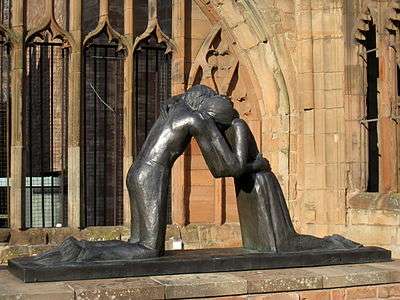Josefina de Vasconcellos

Josefina Alys Hermes de Vasconcellos (26 October 1904 – 20 July 2005) was an English sculptor of Brazilian origin. She was at one time the world's oldest living sculptor. She lived in Cumbria much of her working life. Her most famous work includes Reconciliation (Coventry Cathedral, University of Bradford); Holy Family (Liverpool Cathedral, Gloucester Cathedral); Mary and Child (St. Paul's Cathedral); and Nativity (at Christmas) at St. Martin-in-the-Fields (Trafalgar Square).
Early life
De Vasconcellos' father was a wealthy Brazilian diplomat. Her mother was an English Quaker who helped ensure Josefina was able to develop her artistic talents through a childhood shared between England and Brazil. In 1921 she gained a scholarship to the Royal Academy of Art, studying with William MacMillan. At the age of 19 she was accepted to the Académie de la Grande Chaumière in Paris, where she studied under Antoine Bourdelle, one of Auguste Rodin's assistants. Before returning to Britain, she also studied with Libero Andreotti in Florence.
Career
Josefina de Vasconcellos attained runner up in the 1930 Prix de Rome contest. That same year she met the artist Delmar Banner (died 1983), of German origin, who had anglicised his name and who was an Anglican lay preacher. They married in 1930. This was a great shock to her parents, who had forbidden the subject of religion in their home. Her husband led her to be received into the Church of England, and the topic of faith came to run through much of her artistic work. Examples of his work can be seen in the collection of Lakeland Arts Trust at Abbot Hall Kendal and online;[1] they are mostly Lake District landscapes in mid-20C British style, but one of Bowfell currently hanging at Blackwell House has striking cubist elements. The couple adopted two boys, and the family settled in a farmhouse at The Bield in Little Langdale at the heart of the Lake District, where she made a studio in an outhouse. In 1967, through associations with Pelham House in West Cumbria, the family helped found the Beckstone Centre, an Outward Bound-type facility for disadvantaged boys at Beckstones in the Duddon Valley.[2]

In 1975, she initiated the founding of The Harriet Trust, on the shores of the Duddon Estuary at Millom so that disabled children could enjoy nature holidays within a purpose-built dwelling; the modified former fishing trawler The Harriet was used as a recreation space. It was such work that led to de Vasconcellos being honoured in 1985 with the Order of the British Empire.
Throughout her life de Vasconcellos undertook numerous large commissions that were vehicles for her flowing, naturalistic style of carving. At times this contrasted with fashion, for example the period where mainstream sculptured art was toying with the more abstract styles of Henry Moore and Barbara Hepworth. Although raised as an atheist, de Vasconcellos' works were frequently religious. Much of her sculpture can be found in parish churches and cathedrals around Britain, including St. Paul's Cathedral and St. Michael's, Coventry, as well as cathedrals in Blackburn, Bristol, Carlisle, Gloucester, Liverpool, Norwich and Wells and in parishes such as St Bees Priory and St Mary's Church, Warrington.
Major works

De Vasconcellos' first commissioned work was in 1924 for the Church of Saint Valéry in Varengeville-sur-Mer, Normandy, which included a life-sized reclining figure of Saint Valéry under the stone altar.
After the Second World War, she created several war memorials, including the Prince of Peace (1950) in Aldershot (repaired in 1998); The Last Chimera (1950), for the Canongate Kirk in Edinburgh; and The Hand (1955) for the St. Bees' School in Cumbria. In 1955, with the help of students from St. Paul's School, she created Mary and Child, a work that appears in the crypt of St. Paul's. Beginning in 1959, she was commissioned by the vicar of St. Martin-in-the-Fields to construct an annual Nativity scene made of life-sized figures, which became a regular fixture of the Christmas display in Trafalgar Square in London.
In 1977, the faculty of peace studies at Bradford University commissioned a sculpture that de Vasconcellos entitled Reunion. After its restoration in 1994 it was renamed Reconciliation. In 1995, to mark the 50th anniversary of the end of World War II, bronze casts of this sculpture were placed in the ruins of Coventry Cathedral and in the Hiroshima Peace Park in Japan. An additional cast can be found on the grounds of Stormont Castle in Belfast. To mark the opening of the rebuilt German Reichstag (parliament building) in 1999, another cast was placed as part of the Berlin Wall memorial.
Last years
In 1988, illness forced de Vasconcellos to leave Little Langdale, and for a time she was accommodated at Isel Hall near Cockermouth. She was able to find a small cottage and studio at Peggy Hill, Ambleside. She continued her creative work well into her 90s, her final piece (Escape to Light) created in 2001 to commemorate the men of the Independent Off-Shore Rescue Service; it appears at Haverigg on the Cumbrian coast.
Death
De Vasconcellos died at 6 am on 20 July 2005, a few months after her 100th birthday, at the Orchard Lodge nursing home, Blackpool.[3]
References
- ↑ bbc.co.uk/arts/yourpaintings/artists/delmar-harmond-banner
- ↑ The Guardian "Obituary" by Linda Clifford, 21 July 2005
- ↑
External links
- De Vasconcellos's work in Cumbria
- Josefina de Vasconcellos at Cartmel
- The Guardian obituary by Linda Clifford
- The Independent obituary by Margaret Lewis
- Official website for the Josefina de Vasconcellos charitable Trust